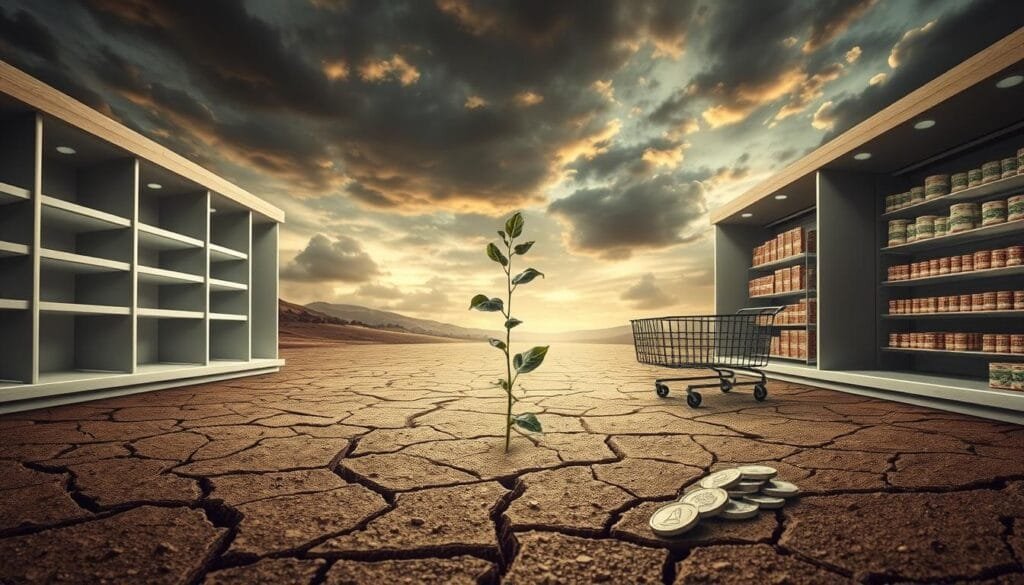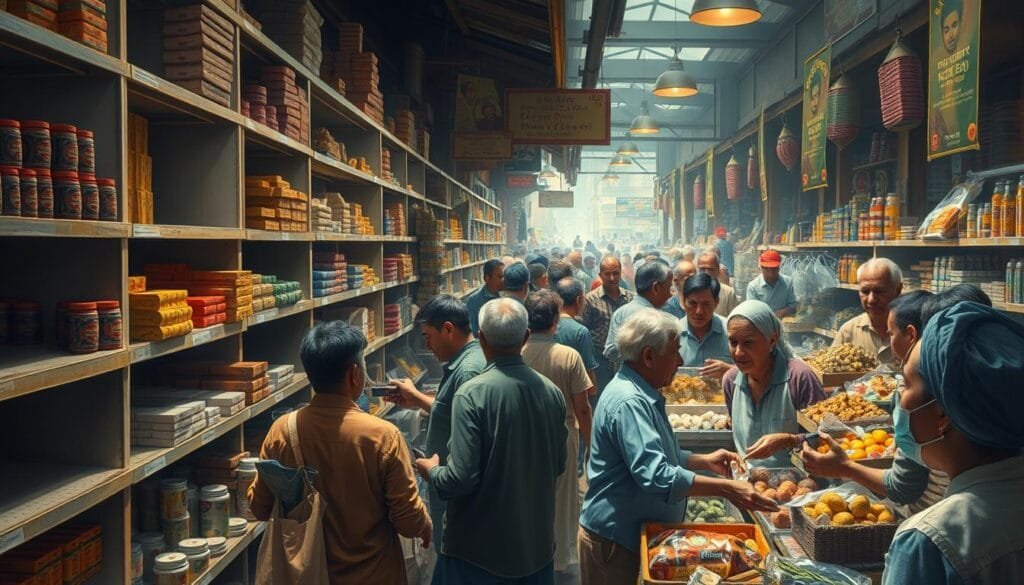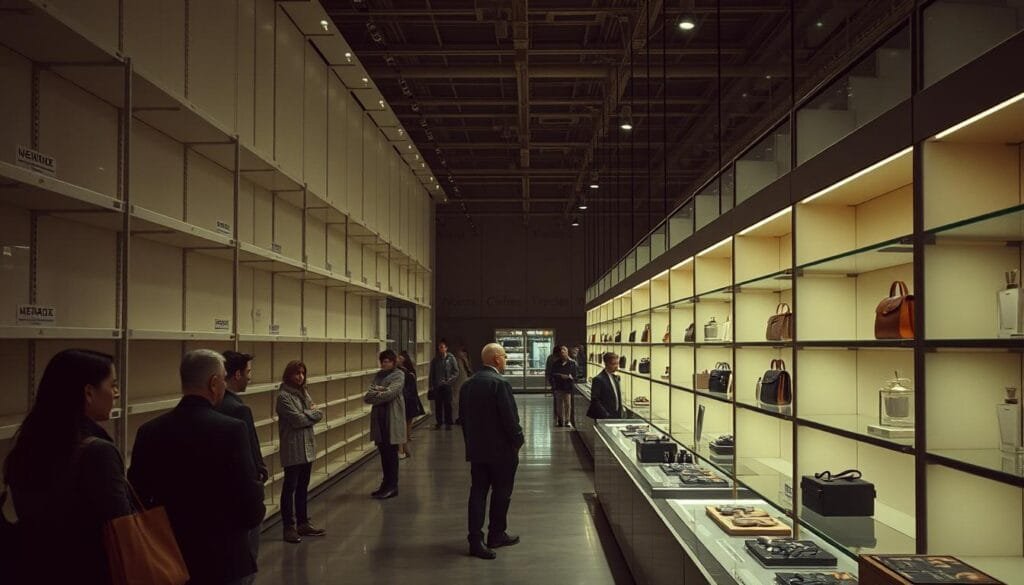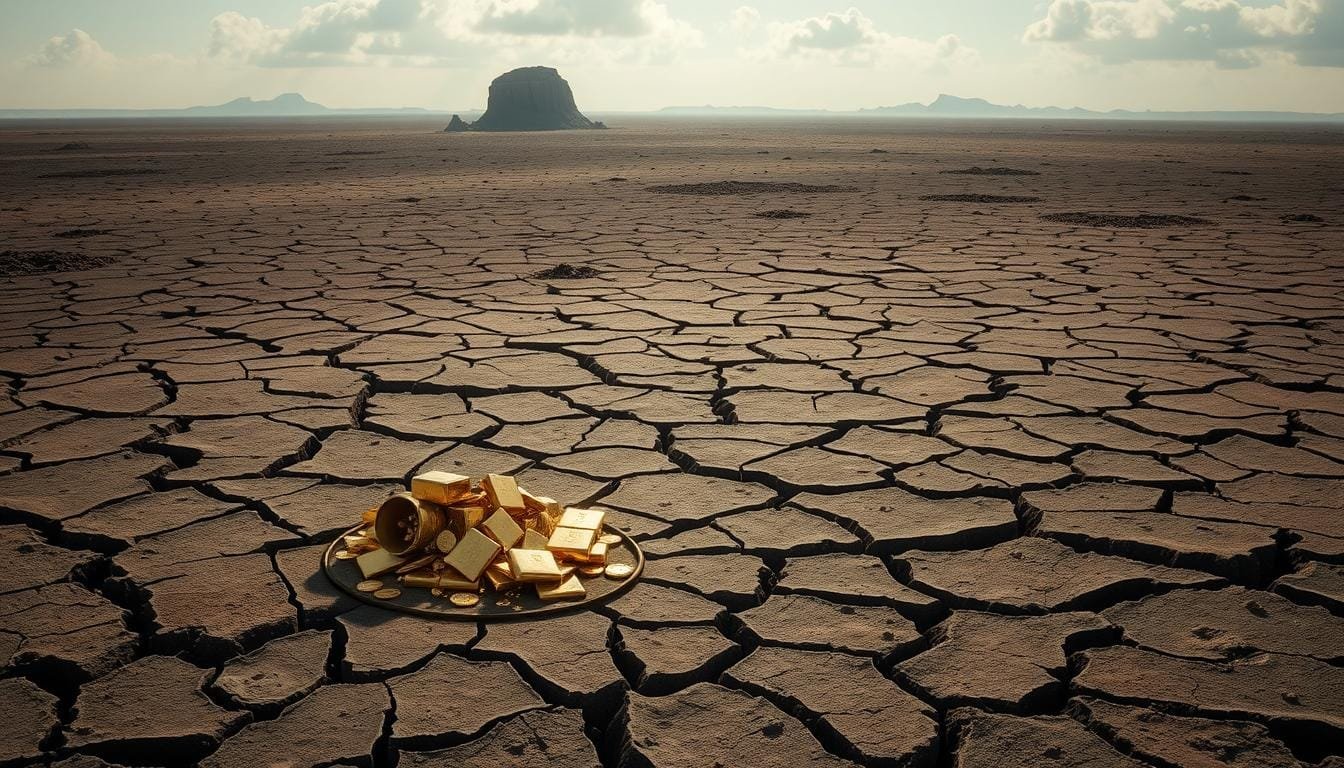Ever wonder why water, so essential, is often cheaper than a diamond? This question gets us to scarcity economics. It looks at managing limited resources against our endless wants. By diving into scarcity basics, we grasp its impact on daily choices and economic policies.
Our world sees a constant clash between demand and supply. Imagine, for instance, 20,000 workers competing for 5,000 managerial positions. This 4:1 worker-manager ratio shows resources are not endless. With our needs growing, deciding how to use resources wisely is key. Scarcity economics highlights why some things are more valuable and how it affects what we choose to buy. It shows the balance we need for growth and wellbeing.
Key Takeaways
- Scarcity occurs when the demand for goods and services exceeds the available supply.
- Economic goods have a positive price due to their limited availability.
- Scarcity economics is central to the decision-making process in resource allocation.
- The ratio of labor pool highlights the need for efficient management of human resources.
- Supply and demand dynamics significantly affect market prices and value of goods.
What Is Scarcity in Economics? The Basics
Scarcity is a fundamental idea in economics. It’s about how resources are limited but our wants are not. This concept affects everything from personal choices to how countries make laws. It’s essential to know scarcity to understand how economies work.
Defining Scarcity
Scarcity in economics means demand is greater than supply. Everything has a cost, showing its scarcity. Time and money are classic examples because we only have so much of them. When something is free, demand can be high, but its value becomes real when it costs something.
Scarcity also includes things like labor and time. For example, in 2024, there were 167 million workers in the U.S. This shows labor is limited. Each person deals with not having enough time or money. Someone without a job might have time but no money. Meanwhile, a busy executive could have money but no time for themselves.
The Role of Demand and Supply
Demand and supply are crucial in scarcity. When more people want something than is available, its price goes up. Take pumpkin drinks at Starbucks. Their price jumps from $6.67 to $7.81 in the fall because everyone wants them and they’re only around for a short time.
Companies like eBay and Amazon show how scarcity affects us. They use tricks like countdowns and fast shipping to make us want to buy now. Marketers use our fear of losing out to encourage quick buys. Zappos uses “limited stock” warnings to make customers buy immediately.
Scarcity means we have to choose what to give up. This is true for families planning their spending or picking where to live. We see how not having enough affects all our choices, showing scarcity’s role in our lives.
| Resource | Scarcity Indicator | Impact |
|---|---|---|
| Time | Unemployed vs. Executives | Availability for personal activities |
| Money | Income levels | Meeting basic needs versus excessive wealth |
| Labor | 167 million workers | Finite nature of workforce |
| Commodities | Market prices | Seasonal demand and availability |
Impact of Scarcity on Consumer Choices
Scarcity changes how we decide what to buy. When there’s not much available, we must choose carefully, facing trade-offs. For example, people hoarded toilet paper when COVID-19 hit, showing scarcity’s strong effect. This scarcity shapes the market, making us prioritize and make hard choices.

Opportunity Cost
Opportunity cost is key to understanding how scarcity affects us. Choosing one thing means losing another’s value. For instance, choosing rare sneakers over a regular pair means giving up on something else. These rare sneakers can sell for over $1,000, showing how scarcity changes what we buy.
Limited Resources and Consumer Decisions
Deciding wisely when things are scarce means thinking hard about trade-offs. Scarcity can make us feel scared or stressed, leading to quick buys. We react to signs of not having enough, which sways our shopping choices. Having less ramps up how much we want things, making us act fast to buy.
Scarcity shows why it’s crucial to use resources well. We all face many choices that have hidden costs. For example, in class activities, students explore the value and cost of different items. Every choice means giving something up, proving there’s always a cost, even in free offers.
This is important for buyers and sellers. Scarcity not only influences what we buy but also sparks new ideas and competition. Companies use urgency in their ads to increase sales. Exclusive deals can lift sales by 30%, and countdowns can push up sales by up to 47%.
| Aspect | Impact Due to Scarcity | Data/Statistics |
|---|---|---|
| Consumer Behavior | Impulse Buying, Anxiety, Fear | 70% of consumers anxious about missing out |
| Market Prices | Higher Prices, Increased Value | Price increases up to 200% for limited-edition items |
| Decision Complexity | Trade-offs, Opportunity Costs | Opportunity costs influence every economic choice |
| Sales Conversions | Boosted by Scarcity Tactics | Increase by 30% through exclusive access strategies |
Scarcity in Natural Resources
Natural resources are becoming scarce as demand soars and supplies lessen. We’ll discuss what causes this loss and its environmental costs. It’s a critical issue that needs our attention.
Overconsumption and Depletion
Overuse of resources like water, oil, and minerals is alarming. Economic growth and more people in places like developing regions contribute to this. For example, sub-Saharan Africa saw its population jump from 177 million to 657 million from 1950 to 2000. This strains local resources severely. Also, overgrazing and drought turn about 900 square miles into desert each year in the Qinghai-Tibet Plateau.
In the U.S., the jump in consumption rates is worrying, especially for oil. Despite technological progress, we use resources faster than we can save them. Costs are climbing, which alarms many.
Environmental Impact and Costs
The environment pays a high price for our overuse of natural resources. This misuse causes climate change and harms nature’s balance. In Rwanda, for instance, scant resources helped spark the 1994 genocide. Apartheid in South Africa showed how unequal resource access can be, with whites controlling most of the land.
This scarcity also brings economic and social issues. In Karachi, rapid population growth led to many living in poor conditions by the early 1990s. This shows how resource overuse can make life harder and widen social gaps.
This report on natural resource scarcity explains the economic and environmental problems from using too much. It shows why we must use resources wisely, as prices rise when supplies drop.
| Resource | Depletion Rate | Environmental Impact |
|---|---|---|
| Water | High | Severe droughts, desertification |
| Oil | Moderate to high | Air pollution, carbon emissions |
| Minerals | Variable | Habitat destruction, soil contamination |
We’ve made progress, like 24% less soil erosion from 1982 to 1992 in the U.S. Yet, we still use resources faster than we should. We need strong plans to tackle this issue.
Scarcity and Market Dynamics
It’s key to understand how scarcity and the law of supply and demand shape our economy. Scarcity affects industries and how we as consumers behave. By looking closely, we learn about its complex role in market dynamics.

Law of Supply and Demand
When something is rare but lots want it, its price goes up. Ideally, supply meets demand perfectly. But often, they don’t match, leading to too much or not enough of a product.
For example, if wheat gets cheaper, farmers may grow less. This causes a shortage. Companies sometimes make things seem rarer to make us want them more. They may say an offer is “for a limited time” to rush us. Studies show we value things more when they’re scarce. Luxury and tech brands use this to their advantage.
Types of Scarcity
Scarcity comes in different forms. Structural scarcities happen due to location or big system issues. Like how the Japan earthquake in 2011 left us short on car parts. Temporary scarcities can come from sudden demands or surprises, such as the recent chip shortage.
Some scarcities, like with helium, are because we can’t make more. Others are short-term, caused by delays or sudden interest, like with semiconductor chips. Both climate and trade policies can lead to shortages, changing how much we have of what we need.
| Type of Scarcity | Description | Examples |
|---|---|---|
| Structural Scarcity | Caused by geographic or systemic issues | 2011 Japan earthquake disrupting automotive parts supply |
| Temporary Scarcity | Results from cyclical trends or external shocks | 2021 semiconductor chip shortage |
| Absolute Scarcity | Involves non-renewable resources | Depletion of helium affecting medical and tech industries |
| Relative Scarcity | Temporary shortages caused by delays and demand spikes | Shortages of protective gear during the pandemic |
Knowing these scarcity types lets businesses and policymakers plan better. They can tackle how scarcities impact our economy. Understanding market dynamics means we can respond well to disruptions.
Intentional Scarcity in Markets
Intentional scarcity, or artificial scarcity, is a strategy to make things feel urgent to consumers. By making fewer products available, companies can boost their appeal.
The sports card industry shows how this works. During the “junk wax” era, too many cards were made, which turned collectors away. But a rare black parallel sports card, only made once, can fetch up to $100,000. In contrast, a common card might only sell for $10. This shows how scarcity can change how we see value.
Luxury brands use scarcity well. “Chicago” Jordan 1 Highs sneakers sell for around $500 because they’re hard to find. Meanwhile, a similar Jordan 1 Mid might cost $135 or less. This strategy makes products more tempting and costly.

Companies like Robinhood and Uber use invite-only access to seem exclusive. Snap Inc. also did this with pop-up events for its spectacles in 2016. This scarcity makes us want the product more. It even leads to buying on impulse, showing the strong effect of artificial scarcity.
The table below shows how using market strategies around scarcity can up a product’s value:
| Product | Market Strategy | Price Point |
|---|---|---|
| Black Parallel Sports Card (1-of-1) | Intentional Scarcity | $100,000 |
| Common Sports Card | Mass Production | $10 |
| Jordan 1 High (“Chicago”) | Limited Release | $500 |
| Jordan 1 Mid | Available in Larger Quantities | $135 |
| Snap Inc. Spectacles | Selective Pop-Up Events | Varies |
This info shows that making things exclusive can drive demand and raise prices. Such strategies are key in influencing what people buy. But, brands need to use these methods wisely to keep trust and build lasting customer bonds.
Scarcity and Monetary Policy
Monetary policy is crucial in handling the limited money supply to control inflation. We need to understand how scarcity affects our economy. This helps us see why the Federal Reserve’s monetary policy is important.
The Federal Reserve’s Role
The Federal Reserve plays a key role in monetary policy and scarcity management. It uses different tools to control the money supply, aiming for economic stability. Adjusting interest rates is one main way it does this.
By changing interest rates, the Federal Reserve affects how much people borrow and spend. It also changes reserve requirements for banks, affecting the money supply. Buying or selling government securities is another way it manages bank reserves and money levels.
Impact of Inflation
Inflation’s impact is a big worry in managing monetary policy. Too much money supply growth can lead to higher inflation. This reduces how much consumers can buy. The Federal Reserve uses policies to reduce the money supply and control inflation.
When inflation rises, prices go up faster than wages, making money less valuable. The Federal Reserve adjusts interest rates and reserve requirements to handle this. These actions help keep the economy stable and prevent inflation from harming growth.
Contractionary policies are used to limit the money available and control inflation. Raising interest rates makes borrowing and spending less attractive. This lowers the amount of money in the economy and helps manage inflation.
| Monetary Policy Tools | Impact on Scarcity | Outcome |
|---|---|---|
| Adjusting Interest Rates | Influences Borrowing & Spending | Stabilizes Inflation |
| Altering Reserve Requirements | Modulates Bank Reserves | Controls Money Supply |
| Open Market Operations | Buys/Sells Government Securities | Directly Affects Money Supply |
The Federal Reserve uses these tools to manage monetary scarcity effectively. Keeping a balance between money supply and demand is vital. This balance prevents inflation from damaging our economic structure.
Conclusion
Understanding scarcity is key in economics, as it helps navigate resource allocation. Resources are limited, and not all desires can be met. This teaches us the value of decision-making by individuals and policymakers.
The concept of scarcity affects everything from labor to time. For instance, the U.S. had over 158 million workers in 2016. Each person daily decides how to split their time between work and leisure.
Scarcity isn’t just about physical things like land or money. It also covers things we can’t hold, like time. Experts in behavioral economics explore how other factors influence our decisions. This adds layers to our understanding of economics.
Environmental economics looks at scarcity through climate change. It focuses on how to use resources wisely to help the planet. As the population grows, these challenges will get even bigger. We’ll need creative and smart strategies to overcome them.
Scarcity challenges everyone, everywhere. By understanding it, we see how important our choices are in distributing resources. Looking ahead, we need sustainable growth and stability. This will require smart decisions from everyone involved. As we go forward, learning from scarcity is crucial for creating fair and strong economic plans for the future.
FAQ
What is scarcity in economics?
Scarcity in economics is when we have endless needs but limited resources. It’s about making choices on how to use what we have wisely. This way, we can meet as many needs as possible.
How does scarcity affect consumer decision-making?
Scarcity makes consumers think hard about what they need most. They have to choose, knowing they can’t have everything. This choice means giving up other options, which is known as opportunity cost.
What is the role of demand and supply in scarcity?
Demand and supply play a key role in scarcity. If more people want something that’s hard to find, its value goes up. This balance between wanting and having shapes prices and how we trade.
How does scarcity relate to natural resources?
Scarcity hits natural resources like water and oil hard. It leads to shortages and big problems, like harm to our planet. More people wanting more stuff makes this even tougher, raising costs and harming health and nature.
What are the types of scarcity in market dynamics?
Two main scarcities shake up the market. Structural scarcity is about location or system issues. Temporary scarcity happens because of changing trends. Knowing these types helps us find smart ways to deal with scarcity in the economy.
How does artificial scarcity work in markets?
Artificial scarcity is when companies make things rare on purpose. By making something limited, like a special edition item, it seems more special. This makes people want to buy quickly, pushing demand and prices up.
What is the Federal Reserve’s role in managing scarcity?
The Federal Reserve helps control how much money there is to keep prices stable. It can change interest rates, tweak bank rules, or buy and sell stuff to help. This keeps the economy steady and fights inflation.
How does scarcity impact inflation?
Scarcity can push prices up when things or money are hard to get. The Federal Reserve works to keep this in check. That way, money keeps its value and the economy stays balanced.
